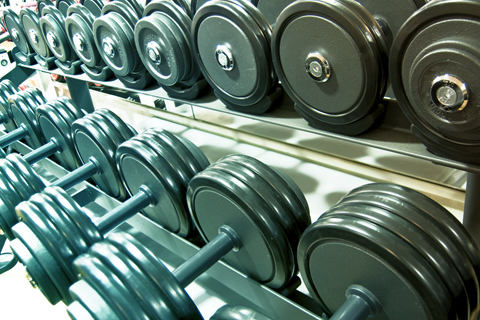Strength Training – Beating The Plateau
by Matt Hodges
14 June 2011
 The subject of strength training is as diverse as any other area of fitness, with numerous protocols and regimes that claim to make you stronger.
The subject of strength training is as diverse as any other area of fitness, with numerous protocols and regimes that claim to make you stronger.
Most trainers have their preferred way of getting their clients strong and most certified Strength & Conditioning coaches have a set method in which they use. This is all well and said but in my opinion only a handful of these ‘strength and conditioning coaches’ actually practice what they preach. Here’s how to undertake strength training and make sure you’re beating the plateau.
Why is strength and conditioning used?
This should be fairly obvious but some of the main factors are:
Breaking client plateaus (again, effective periodised plans)
The client has been training with you for 4 months now, their goals slightly change, and they are now competent with most things you throw at them. Its now time to start a strength to hypertrophy phase. Bring their strength up and everything else will follow.
Injury rehabilitation
A client comes to you with a busted knee. This takes out most knee flexion exercises and spinal loading. Through a more rigid and focussed strength program the knee (more so the VMO) can get stronger thus allowing the client to do more volume work.
A sound basis for the introduction of advanced fat loss training
Lets say a client comes in who is a pure beginner. With a concentration on most of the bigger compound lifts the client will then be strong enough to cope with compound circuits.
Works well in breaking up hypertrophy phases.
As anyone would know who trains in this area, strength often relates to mass. This is not always true but most of the muscle groups in hypertrophy need heavy load, therefore a period of focussed strength training will allow the muscle to lift more which would then relate to mass.
Through my own experience I have developed a way in which I could not only get the client progressively stronger but write a program that I could effectively periodise.
My strength breakdown….
When attempting a strength phase for myself or any of my clients I always like to take a week to go through one rep max lifts. My concentration is mainly on Olympic lifts, large compound exercises as these produce the higher quality strength gains and as we know produce the larger amount of Growth Hormone release (good for fat loss AND hypertrophy).
Rep Max
After the one rep maxs’ have been found on all the large lifts I decide how long the period of strength training is going to be. For regularity I tend to go for a 10 week phase. This however, is not set in stone as we will discuss later.
The basis of my strength program will follow a 2.5kg increase each week on each lift. Each lift is performed twice a week e.g
Week 1 Week 2 Week 3
BB Squats – 70kg BB Squats – 72.5kg BB Squats – 75kg
10 Week Phase
The 10 week phase is there to meet their one rep max at the end however instead of doing one rep you will be lifting for 4 reps at this point thus breaking your plateau by a considerable amount.
Therefore over 10 weeks the weight is equal to 25kg so I deduct 25kg from their one rep max and start week one at this weight e.g
One Rep Max Week 1 Week 2
BB Squats – 95kg BB Squats – 70kg BB Squats – 72.5kg
You will then see that over the 10 week phase the BB Squat at 95kg will be met AND BEATEN!
An example of a client of mine who used this technique is below. Here are his results over a 12 week phase…
Exercise |
Rep Max Week (1-2 Reps) |
Week 12 |
| Barbell Back Squat | 80kg | 120kg for 4 reps |
| Rack Pull | 90kg | 110kg for 6 reps |
| Barbell Flat Chest Press | 40kg | 65kg for 5 |
| Pull Ups | B/W for 3 reps | B/W + 5kg for 5 reps |
| Barbell Shoulder Press | 25kg | 35kg for 5 |
| Inverted Row | B/W for 8 | B/W +15kg for 5 |
| Barbell Forward Lunge | 30kg | 50kg for 5 |
Mobilisation & ‘Warm Up’ Sets
I know most of us love to jump our clients onto the rollers to mobilise tissue but I tend to keep this short for the pre-exercise and introduce it throughout the workout in the rest times. I feel that clients benefit more from active warm up sets as it can be used to stretch the muscle dynamically. Use the bench press for example, I get the client to pump out the bar for one set to mobilise the muscle and the joints. A good few seconds at the stretch point works nicely!
Reps, Sets, Rest & Tempo
I like to keep a traditional strength rep range of 4 reps for around 6 sets per exercise. This may seem a lot in terms of sets but you can superset some push pull exercises so that your not slogging out a 2 hour gym session.
Im a big one for tempo. This is probably the most important part of the lift when it comes to strength. There are so many ways of accentuating the eccentric phase but I like to go for a 4 second eccentric, one second at low point, then explode through the concentric phase.
Example Workout
Exercise |
Tempo |
Reps |
Sets |
Load |
Rest |
|||
| ec | h | co | per week | |||||
| Barbell Back Squat | 4 | 1 | x | 4 | 6 | 2.5kg increase | 03:00 | |
| Lat Pulldown | 4 | 1 | x | 4 | 6 | 2.5kg increase | 03:00 | |
| Barbell Bench Press | 4 | 1 | x | 4 | 6 | 2.5kg increase | 03:00 | |
| Rack Pull | 4 | 1 | x | 4 | 6 | 2.5kg increase | 03:00 | |
| Barbell Shoulder Press | 4 | 1 | x | 4 | 6 | 2.5kg increase | 03:00 | |
| Bulgarian Split Squat | 4 | 1 | x | 4 | 6 | 2.5kg increase | 03:00 | |
The exercise selection is subjective. Use what you think is right for your client. Single arm and single leg work needs to be used where appropriate. I don’t feel that there should be any emphasis on always using single limb work or making one exercise the main focus unless you are splitting your week up to more than 3 sessions which, as we know, most of our clients do not do.
This is a tried and tested method which I regularly use with my clients.
Give it a go and be strict on form and tempo. Enjoy.
This article was written by Matt Hodges, you can see all his articles here.






